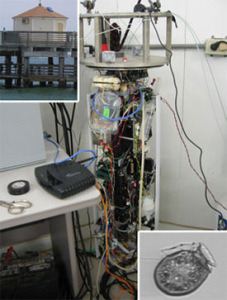A scientific study funded by NCCOS’s ECOHAB program, shows phytoplankton community structure changing rapidly, often by the hour, as tropical cyclones pass by. A revolutionary sampling instrument, the Imaging FlowCytobot (IFCB)allows hourly real-time continuous observation of phytoplankton changes. Over time the IFCB provides an extraordinary view of phytoplankton community structure.
Prior studies of phytoplankton responses to the passage of tropical cyclones (i.e., tropical depressions, storms, hurricanes) showed increased abundance from nutrient entrainment caused by wind-forced upwelling, water mixing, storm surge, freshwater runoff, and sediment resuspension. However sampling frequency was limited to days, weeks and even months. This is the first study to have real-time data on phytoplankton response to storm systems.

In 2010, four tropical cyclones (two during June–July and two during September) struck the southeast Texas Gulf of Mexico coastline near the Guadalupe, Mission-Aransas and Nueces estuaries and the Aransas Pass. Since then, the Texas A&M University project sponsored by NCCOS continues to deploy an IFCB at the University of Texas Marine Science Institute pier located in the Port Aransas Ship Channel. The IFCB collects and analyzes a sample of near-surface water continuously almost every 20 minutes. The IFCB data shows the phytoplankton community rapidly responding to the passage of the tropical cyclones with increased abundance. Responses to saltwater storm surges revealed an increase of diatoms; freshwater discharges triggered increases in dinoflagellates and other flagellates (e.g., prasinophytes, euglenophytes, and cryptophytes) relative to the other groups. After the storm passes, project scientists have observed substantial increases in diatoms (dominated by Thalassiosira), whereas the community response to the September 2010 storm dominated by two dinoflagellate species (Akashiwo sanguinea and Polykrikos hartmannii). The abundances of these three taxa are the highest recorded from the IFCB time series. Both dinoflagellates can form massive blooms that turn the water red to brown and A. sanguingea caused bird mortality events on the West Coast.

The short-term responses of the phytoplankton community revealed in this study emphasize the need for high temporal resolution sampling to fully capture the effects of tropical cyclones. Details of the study can be found in the scientific paper published in the journal Limnology and Oceanography .
For more information, contact Quay.Dortch@noaa.gov.
